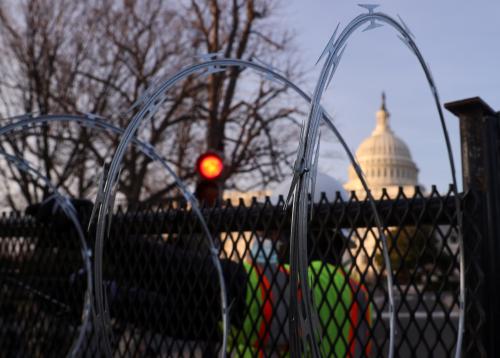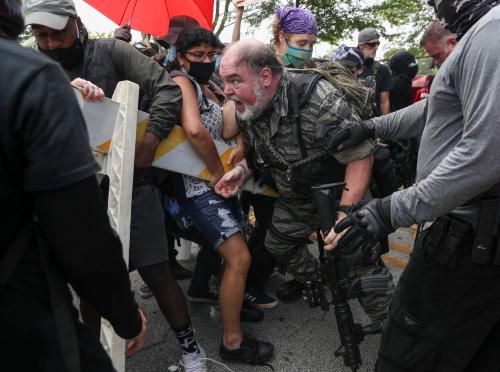Is it really possible that America could face the possibility of civil war in the near future? It may seem unthinkable, and yet there’s much to worry about.
A 2021 national survey by pollster John Zogby found a plurality of Americans (46%) believed a future civil war was likely, 43% felt it was unlikely, and 11% were not sure. War seemed more likely for younger people (53%) than older ones (31%), and for those residing in the South (49%) and Central/Great Lakes region (48%) relative to those in the East (39%).
Meanwhile, Republican Rep. Madison Cawthorn of North Carolina made a false claim regarding election integrity and said, “If our election systems continue to be rigged, then it’s going to lead to one place and that’s bloodshed. … There’s nothing I would dread doing more than having to pick up arms against a fellow American.” (Translation: “It would be a shame if false election claims cause a civil war.”) These kinds of remarks should not be taken lightly.
The recent survey did not ask why people thought civil war was possible or how it could happen. But we believe there are several forces pushing many to imagine the unthinkable.
Hot-button issues: Racial equity, gun control, abortion, election legitimacy, climate change, vaccines, masks—the list goes on. Cultural, economic, and political issues generate outrage and hostility. We already are seeing “border wars” via federalism, with individual states passing major legislation that differs considerably from that in other places. As an illustration, a new Texas law virtually outlaws abortions after six weeks of pregnancy (a time at which many women do not even know they are pregnant), while other states continue to uphold the 1973 Roe v. Wade framework and a clear majority of Americans support legalized abortion.
High levels of inequality and polarization: These hot-button issues are driven in part by the widespread and interrelated divisions that burden the country. Separated by ideology, race, gender, living standards, and opportunities for education and economic advancement, different groups have dramatically different views about public policy and American society. There can be large variations in opinions, depending on the issues.
Winner-take-all politics: The sharp delineation in perspectives does not, in itself, have to bring government to a halt; Tip O’Neill and Ronald Reagan were able to negotiate and reach agreements, for instance. But today’s toxic atmosphere makes it difficult to negotiate on important issues, which makes people angry with the federal government and has helped create a winner-take-all approach to politics. When the stakes are so high, people are willing to consider extraordinary means to achieve their objectives. Winning becomes the goal over almost every other consideration, which leads to …
Belief that the other side doesn’t play fair: One of the most worrisome contemporary signs is the widespread belief that “the other side” is ruthless. Liberals see conservatives limiting voting rights, endangering democracy, and ignoring procedural safeguards, while conservatives think progressives are turning to socialism and disrespecting freedom and liberty. Viewing others with great suspicion and doubting their motives is an indication that faith in the system is eroding and there is little good will in how people deal with one another
Prevalence of guns: As if the problems above were not enough, America has an extraordinary number of guns and private militias. According to the National Shooting Sports Foundation, a gun trade association, there are “434 million firearms in civilian possession” in the United States—1.3 guns per person. Semi-automatic weapons comprise around 19.8 million in total, making for a highly armed population with potentially dangerous capabilities.
Private militias: Rachael Levy of The Wall Street Journal writes that “several-hundred private-militia groups now exist around the country, and they have proliferated in recent years.” Current militias generally are made up of right-wing white men who worry about changing demographics, stagnating wages, and how the shift to a multi-racial and multi-ethnic America will affect them. These groups create the potential for violence because they tend to attract radicalized individuals, train members for violent encounters, and use social media to reinforce people’s existing beliefs. They openly talk about armed rebellion, and some members of these organizations already have engaged in violence and are helping others plan their own assaults and shootings.
Still, civil war is not inevitable
Take a deep breath. Despite the factors above, civil war is not inevitable. Indeed, that scenario faces several limiting factors that hopefully will stop the escalation of conflict. Historically, other than during the 1860s and the Reconstruction period, these kinds of forces have limited mass violence and kept the country together.
Most of the organizations talking about civil war are private, not public entities: When Southern states seceded in 1860, they had police forces, military organizations, and state-sponsored militias. That varies considerably from today, where the forces who have organized for internal violence are mostly private in nature. They are not sponsored by state or local governments and do not have the powers of government agencies. They are voluntary in nature and cannot compel others to join their causes.
There is no clear regional split: We do not have a North/South schism similar to what existed in the 19th century. There are urban/rural differences within specific states, with progressives dominating the cities while conservatives reside in rural communities. But that is a far different geographic divide than when one region could wage war on another. The lack of a distinctive or uniform geographic division limits the ability to confront other areas, organize supply chains, and mobilize the population. There can be local skirmishes between different forces, but not a situation where one state or region attacks another.
A history of working through ballot box: Despite Republicans’ increasing (and false) accusations that elections they lose are fraudulent—GOP candidate Larry Elder made unfounded claims of voter fraud in the recent California recall election before the election even happened!—America has a history of resolving conflict through electoral and political means, not combat.
Although there has been a deterioration of procedural safeguards and democratic protections, the rule of law remains strong and government officials are in firm position to penalize those who engage in violent actions.
We expect that these limiting factors will allow the country to avoid a full-scale civil war. However, with nearly half the country believing this conflict to be likely, we need to take that scenario seriously. This is, after all, not the first time the country has been sharply divided. The 1860s conflagration—a needed step to rid the nation of slavery—lasted four years, cost over 600,000 lives, and had a devastating impact on the economy, political system, and society as a whole. It was a shocking breach of the national union by slave-holders and a demonstration of what happens when basic governance breaks down.
We should not assume it could not happen and ignore the ominous signs that conflict is spiraling out of control. Even if we do not end up in open combat, there could be an uptick in domestic terrorism and armed violence that could destabilize the country. It is time to take steps to safeguard democracy, address societal concerns, and defuse our current tinderbox.





Commentary
Is the US headed for another Civil War?
September 16, 2021